小升初英语专题讲解十 介词
- 格式:doc
- 大小:478.52 KB
- 文档页数:9
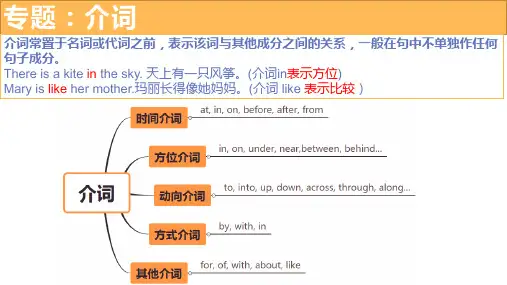
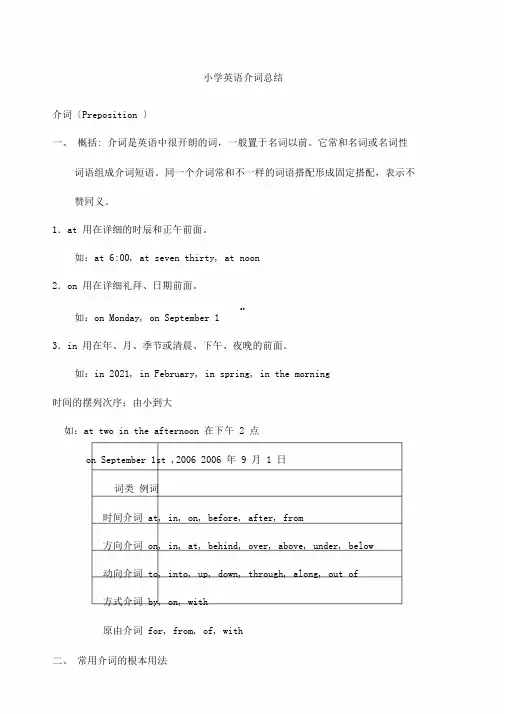
小学英语介词总结介词〔Preposition 〕一、概括: 介词是英语中很开朗的词,一般置于名词以前。
它常和名词或名词性词语组成介词短语。
同一个介词常和不一样的词语搭配形成固定搭配,表示不赞同义。
1.at 用在详细的时辰和正午前面。
如:at 6:00, at seven thirty, at noon2.on 用在详细礼拜、日期前面。
st如:on Monday, on September 13.in 用在年、月、季节或清晨、下午、夜晚的前面。
如:in 2021, in February, in spring, in the morning时间的摆列次序:由小到大如:at two in the afternoon 在下午 2 点on September 1st ,2006 2006 年 9 月 1 日词类例词时间介词 at, in, on, before, after, from方向介词 on, in, at, behind, over, above, under, below动向介词 to, into, up, down, through, along, out of方式介词 by, on, with原由介词 for, from, of, with二、常用介词的根本用法at ①表示时间: I go to school at seven every day 我每日清晨 7 点去上学。
②表示在某一详细地址: He is standing at the bus stop 他站在公共汽车站。
③表示动作的方向、目标: Let me have a look at the picture让我看看这幅图。
④用于某些固定搭配: at once 马上、马上 at last 最后at the same time 同时at first 开始时not at all 一点也不about ①表示大概时间: I's about six o'clock now.此刻大概6 点钟了。
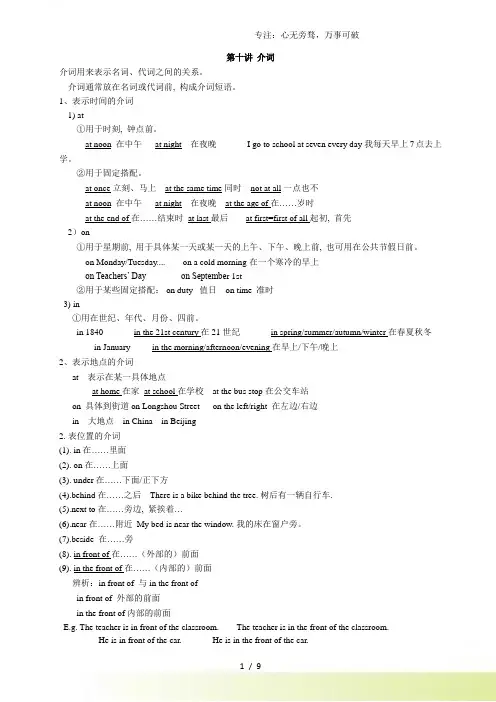
第十讲介词介词用来表示名词、代词之间的关系。
介词通常放在名词或代词前, 构成介词短语。
1、表示时间的介词1) at①用于时刻, 钟点前。
at noon 在中午at night 在夜晚I go to school at seven every day 我每天早上7点去上学。
②用于固定搭配。
at once 立刻、马上at the same time 同时 not at all 一点也不at noon 在中午at night 在夜晚at the age of在……岁时at the end of在……结束时at last最后at first=first of all起初, 首先2)on①用于星期前, 用于具体某一天或某一天的上午、下午、晚上前, 也可用在公共节假日前。
on Monday/Tuesday.... on a cold morning在一个寒冷的早上on Teachers’ Day on Septembe r 1st②用于某些固定搭配: on duty 值日 on time 准时3) in①用在世纪、年代、月份、四前。
in 1840 in the 21st century在21世纪in spring/summer/autumn/winter在春夏秋冬in January in the morning/afternoon/evening在早上/下午/晚上2、表示地点的介词at 表示在某一具体地点at home在家at school在学校at the bus stop在公交车站on 具体到街道on Longshou Street on the left/right 在左边/右边in 大地点in China in Beijing2.表位置的介词(1). in在……里面(2). on在……上面(3). under在……下面/正下方(4).behind在……之后There is a bike behind the tree. 树后有一辆自行车.(5).next to在……旁边, 紧挨着…(6).near在……附近My bed is near the window. 我的床在窗户旁。
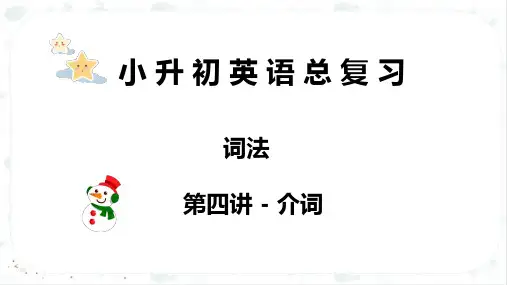
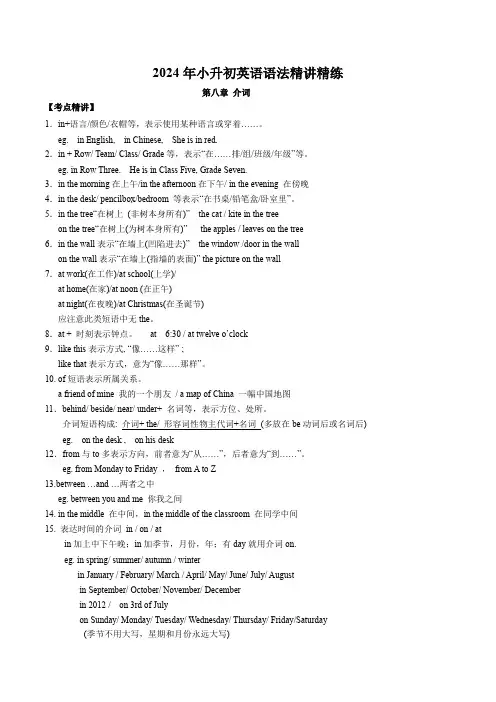
2024年小升初英语语法精讲精练第八章介词【考点精讲】1.in+语言/颜色/衣帽等,表示使用某种语言或穿着……。
eg. in English, in Chinese, She is in red.2.in + Row/ Team/ Class/ Grade等,表示“在……排/组/班级/年级”等。
eg. in Row Three. He is in Class Five, Grade Seven.3.in the morning在上午/in the afternoon在下午/ in the evening 在傍晚4.in the desk/ pencilbox/bedroom 等表示“在书桌/铅笔盒/卧室里”。
5.in the tree“在树上(非树本身所有)” the cat / kite in the treeon the tree“在树上(为树本身所有)” the apples / leaves on the tree6.in the wall表示“在墙上(凹陷进去)” the window /door in the wallon the wall表示“在墙上(指墙的表面)” the picture on the wall7.at work(在工作)/at school(上学)/at home(在家)/at noon (在正午)at night(在夜晚)/at Christmas(在圣诞节)应注意此类短语中无the。
8.at + 时刻表示钟点。
at 6:30 / at twelve o’clock9.like this表示方式, “像……这样” ;like that表示方式,意为“像……那样”。
10. of短语表示所属关系。
a friend of mine 我的一个朋友/ a map of China 一幅中国地图11.behind/ beside/ near/ under+ 名词等,表示方位、处所。
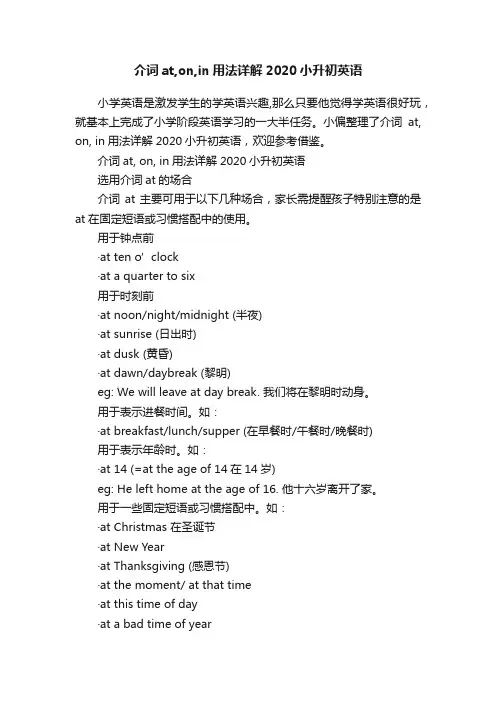
介词at,on,in用法详解2020小升初英语小学英语是激发学生的学英语兴趣,那么只要他觉得学英语很好玩,就基本上完成了小学阶段英语学习的一大半任务。
小偏整理了介词at, on, in用法详解2020小升初英语,欢迎参考借鉴。
介词at, on, in用法详解2020小升初英语选用介词at的场合介词at主要可用于以下几种场合,家长需提醒孩子特别注意的是at在固定短语或习惯搭配中的使用。
用于钟点前·at ten o’clock·at a quarter to six用于时刻前·at noon/night/midnight (半夜)·at sunrise (日出时)·at dusk (黄昏)·at dawn/daybreak (黎明)eg: We will leave at day break. 我们将在黎明时动身。
用于表示进餐时间。
如:·at breakfast/lunch/supper (在早餐时/午餐时/晚餐时)用于表示年龄时。
如:·at 14 (=at the age of 14在14岁)eg: He left home at the age of 16. 他十六岁离开了家。
用于一些固定短语或习惯搭配中。
如:·at Christmas 在圣诞节·at New Year·at Thanksgiving (感恩节)·at the moment/ at that time·at this time of day·at a bad time of year·at first (起初)·at last (终于)选用介词on的场合用于星期、日期(包括该天的各部分)前·on Sundays/weekdays·on Monday morning / afternoon / evening【温馨提示】“在周末”既可以说at weekends,也可以说on weekends。
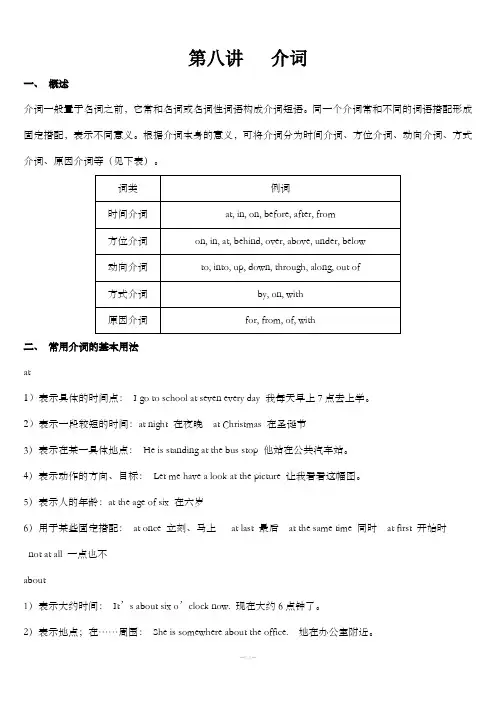
第八讲介词一、概述介词一般置于名词之前,它常和名词或名词性词语构成介词短语。
同一个介词常和不同的词语搭配形成固定搭配,表示不同意义。
根据介词本身的意义,可将介词分为时间介词、方位介词、动向介词、方式介词、原因介词等(见下表)。
二、常用介词的基本用法at1)表示具体的时间点:I go to school at seven every day 我每天早上7点去上学。
2)表示一段较短的时间:at night 在夜晚at Christmas 在圣诞节3)表示在某一具体地点:He is standing at the bus stop 他站在公共汽车站。
4)表示动作的方向、目标:Let me have a look at the picture 让我看看这幅图。
5)表示人的年龄:at the age of six 在六岁6)用于某些固定搭配:at once 立刻、马上at last 最后at the same time 同时at first 开始时not at all 一点也不about1)表示大约时间:It’s about six o’clock now. 现在大约6点钟了。
2)表示地点;在……周围:She is somewhere about the office. 她在办公室附近。
3)关于,对于:We are talking about the news. 我们正在谈论新闻。
after1)在……之后:After dinner I watch TV. 晚饭后我看电视。
2)在……后面:He came into the room after me. 他在我后面进了房间。
3)after+某个时间,表示从过去某个时间起过多长时间,多用于过去时,如:She left on Sunday and returned after three days.behind1)在……之后:There is a bike behind the tree. 树后有一辆自行车2)比……晚,迟于:The train is behind time. 火车晚点了by1)在……旁:He is sitting by the bed. 他正坐在床边。
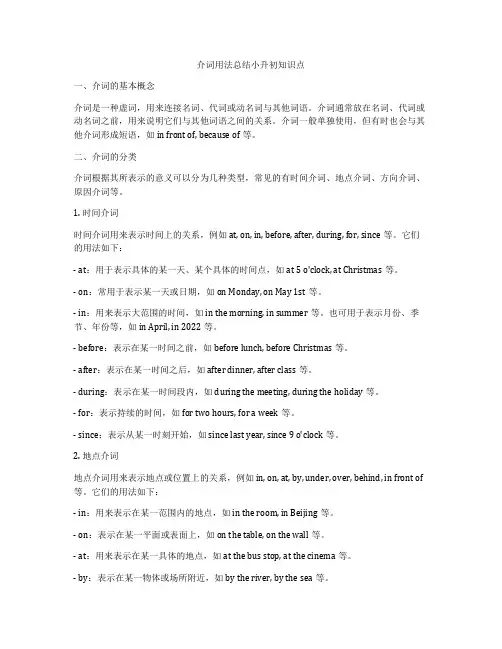
介词用法总结小升初知识点一、介词的基本概念介词是一种虚词,用来连接名词、代词或动名词与其他词语。
介词通常放在名词、代词或动名词之前,用来说明它们与其他词语之间的关系。
介词一般单独使用,但有时也会与其他介词形成短语,如in front of, because of等。
二、介词的分类介词根据其所表示的意义可以分为几种类型,常见的有时间介词、地点介词、方向介词、原因介词等。
1. 时间介词时间介词用来表示时间上的关系,例如at, on, in, before, after, during, for, since等。
它们的用法如下:- at:用于表示具体的某一天、某个具体的时间点,如at 5 o'clock, at Christmas等。
- on:常用于表示某一天或日期,如on Monday, on May 1st等。
- in:用来表示大范围的时间,如in the morning, in summer等。
也可用于表示月份、季节、年份等,如in April, in 2022等。
- before:表示在某一时间之前,如before lunch, before Christmas等。
- after:表示在某一时间之后,如after dinner, after class等。
- during:表示在某一时间段内,如during the meeting, during the holiday等。
- for:表示持续的时间,如for two hours, for a week等。
- since:表示从某一时刻开始,如since last year, since 9 o'clock等。
2. 地点介词地点介词用来表示地点或位置上的关系,例如in, on, at, by, under, over, behind, in front of 等。
它们的用法如下:- in:用来表示在某一范围内的地点,如in the room, in Beijing等。
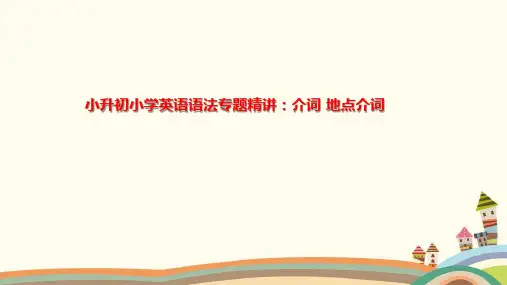
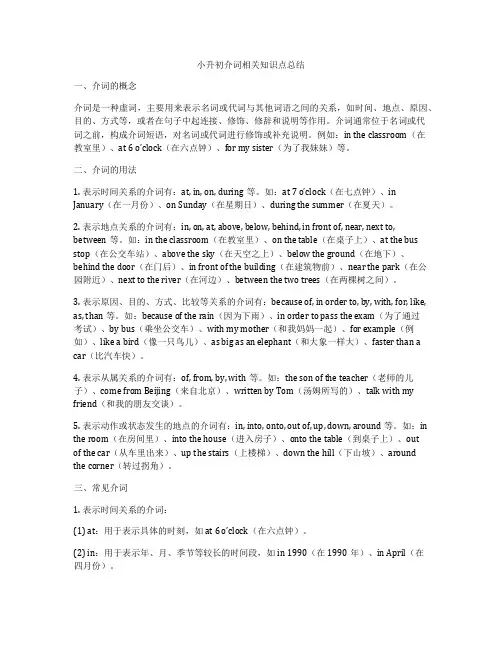
小升初介词相关知识点总结一、介词的概念介词是一种虚词,主要用来表示名词或代词与其他词语之间的关系,如时间、地点、原因、目的、方式等,或者在句子中起连接、修饰、修辞和说明等作用。
介词通常位于名词或代词之前,构成介词短语,对名词或代词进行修饰或补充说明。
例如:in the classroom(在教室里)、at 6 o’clock(在六点钟)、for my sister(为了我妹妹)等。
二、介词的用法1. 表示时间关系的介词有:at, in, on, during等。
如:at 7 o’clock(在七点钟)、in January(在一月份)、on Sunday(在星期日)、during the summer(在夏天)。
2. 表示地点关系的介词有:in, on, at, above, below, behind, in front of, near, next to, between等。
如:in the classroom(在教室里)、on the table(在桌子上)、at the bus stop(在公交车站)、above the sky(在天空之上)、below the ground(在地下)、behind the door(在门后)、in front of the building(在建筑物前)、near the park(在公园附近)、next to the river(在河边)、between the two trees(在两棵树之间)。
3. 表示原因、目的、方式、比较等关系的介词有:because of, in order to, by, with, for, like, as, than等。
如:because of the rain(因为下雨)、in order to pass the exam(为了通过考试)、by bus(乘坐公交车)、with my mother(和我妈妈一起)、for example(例如)、like a bird(像一只鸟儿)、as big as an elephant(和大象一样大)、faster than a car(比汽车快)。
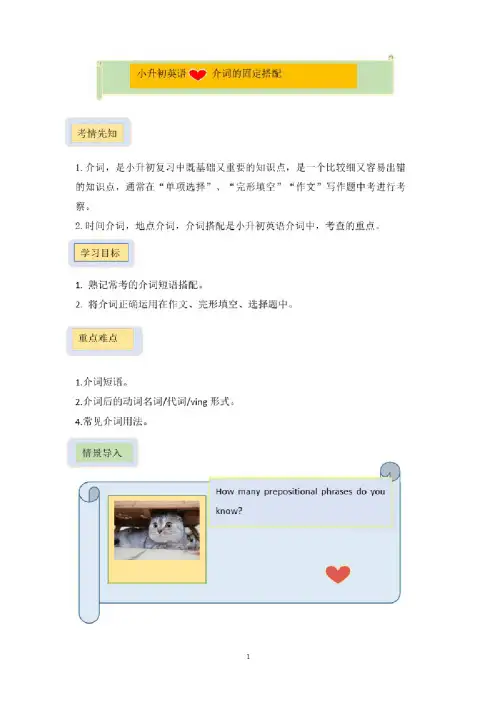
n小升初英语〜 介词的固定搭配考情先知1 .介词,是小升初复习中既基础乂重要的知识点,是一个比较细乂容易出错的知识点,通常在“单项选择”、“完形填空” “作文”写作题中考进行考察°2.时间介词,地点介词,介词搭配是小升初英语介词中.考查的重点。
学习日标1.熟记常考的介词短语搭配。
2.将介词正确运用在作文、完形填空、选择题中。
重点雅点1 .介词短语。
2•介词后的动词名词/代词/ving 形式。
4 .常见介词用法。
情景导入5know?How many prepositional phrases doyou思维导图介词与名词的固定搭配介词的固定搭配介词与形容词的固定搭配介词与动词的固定搭配知识梳理介词定义:英语介词(preposition简写prep.,以下简称介词。
)介词是一种虚词,不能单独作句子成分,只能用在一个名词、代词或相当于名词的结构之前,可以与后面的词一起构成介词短语。
小学阶段常见介词:in,on*with,by,for,at,about*under,of,from,to,during»before,after,beside,behind,below,above,into,over,withint up,dowru介词后+名词/代词/Ving形式。
以下就介词固定搭配进一步分析:介词与名词的固定搭配iu a word总而h之in life一生中in time及时at sea在海上on time准时,按时on foot步行in town在城里in English用英语in a low voice小声地in the distance在远处in public公开地at the table在桌子旁in trouble处于困境of course'与然(可以)in fact事实上in surprise惊奇地in a hurry匆忙,急忙in the end 最后11on show 展出 day by day 逐 H at school 在上学in silence 安静地 at the back of 在……后面ill this way 用这种方法at the same time 同时by hand 手工,(信件)亲手•交付by the end of 到...结束时at the end of 在...结束时out of sight 消失,看不见on duty 值日out of w ork 失业 in the air 在空中on the left/ right 在左/右边on the other side of 在...的另一边to one * s surprise/ joy 使某人吃惊/高兴的是伯ill 上;形about 小心certain about 7 ofgood at 擅 K :siuprised at 对...惊奇famous for 因,…••而出名ready for 为……做好了准备known fbr ,]••••,•而出名late for 迟到diflereiit from 与...不同successful ill 在...成功interested in 1寸・,•…感兴趣disappointed in 对...失望proud of 为...!感到骄傲tired of 厌倦afraid of 害怕short of 短缺fun of 充满busy with 忙于similai, to 与...,相似familiar to 为...所熟悉satisfied with 对,••…满意friendly to 对...友好angiy with 生•…••的气strict with sb .对某人要求严格sure about/ of 肯 定good for 对...有好处介词与动词的固定搭配laugh at嘲笑take part m参加think of想出go on with继续worry about为...担心look like看起来像look for寻找listen to听arri\x in到达(大地方)get to到达wait for等候tliiiik about考虑catch up with赶上,追上pay for付钱买...shout at对...叫嚷play with与...玩耍point at指向hear of听说look fbnvard to盼望fall behmd落后ask for要求,请求look aftei*照看,照料hear from收到……的来信aiiive at到达(小地方)agiee with同意,赞同come from来自talk about谈论point to指向,暗示do well in在……学/做的好take away拿走,带走turn…into…把...变成help・・・with…帮助...做...take/catch hold of抓住take care of照顾have nothing to do with与•••.无关keep---out of不让...进入talk to与...谈话look at(有意识地)看deal with处理decide on决定hand in上交base on以...为根据leave for离开去(另一地)go in for爱好speak to sb.对某人说tie—to—把...系在....上巩固提高■一.选择题。
小升初介词语法讲解地点介词in, at, on above, below, over, under, among, between的用法及区别(1)in, at与on的用法及区别①in表示地点,意为“在…内”,用于内部。
如:There isn’t a cloud in the sky. 天空中没有一片云。
He put his hands in his pockets. 他把手放入口袋。
What’s in the box 盒子里有什么②on意为“在…上面”,用于表面接触,指在一个平面上。
如:What’s on the table 桌子上有什么There was a carpet on the floor. 地板上铺着一块地毯。
③表示“在某地”时,at后面接小地方,in后接大地方。
如:at home在家 at the bus stop在汽车站 in China在中国 in the world 在世界上—(2)above与below的用法及区别above的意思是“在…之上”“高于…”,表示相对高度,不一定是在正上方,它的反义词是below。
如:The plane flew above the clouds. 飞机在云层上面飞行。
The Dead Sea is below sea level. 死海的海面低于海平面。
(3)over与under的用法及区别over的意思是“在…之上”,表示垂直之上,其反义词是under。
如:There is a bridge over the river. 河上有座桥。
There is a boat under the bridge. 桥下有只船。
(4)among与between的用法及区别between一般指“两者之间”。
among用于三个或三个以上的人或物之间,或笼统的一群人或一些物之中。
如:The house stands between two farms. 这座房子位于两个农场之间。
介词介词是表示名词,代词和句中其他词之间关系的词,主要表示地点,位置,时间和方式等。
What can you see in the picture?你在照片里看到了什么?I was born on May 11th.我出生在5月11日。
The library is near the post office.图书馆在邮局附近。
常用介词及用法1. 表示时间的介词。
英语里最常见的时间介词有: at, in , on, before, after和from.(1) at, in 和on 都表示时间。
at 指具体的时间点。
at half past seven. 在七点半。
at eleven o’clockat noon (中午) at that time (那时)in 一般指某一段时间。
in April 在四月份 in the morning/afternoon/evening.In 2013 , in May, 2005(在2005年五月); in three days(三天之后); in Spring; in the 21st century(在21世纪)on指在具体的某一天。
on Sunday. 在星期天。
On April,1st在四月一日on Sunday afternoon 在星期天的早上on a warm morning in April (在四月的一个温暖的早晨)on New Year’s day(新年)(2) before 和after 表示时间的先后顺序。
before 表示“在…..之前”Wash your hands before dinner. 饭前要洗手。
I have to finish my homework before 10 o’clock..我不得不在十点之前做完作业。
after 表示“在….之后”,They often play football after school.他们放学后经常踢足球。
介词(基础篇)1考点一:方位介词方位介词是表示位置和方向的介词.常用的方位介词有on,over,above,under, below,in,at,about,around,behind,between,among,beside,near等.1.on,over和above的用法on,over和above都有“在…上面”的意思,但这三个调在意义上还是有一些区别的。
(1)on表示两个物体的表面相互接触,例如:There is a plant on the desk.书桌上有一株植物。
(植物紧贴着桌面)(2)over表示“在…的正上方”,两个物体表面没有接触,侧如:A lamp hung over the table.桌子上方挂着一盏灯。
(灯和桌面没有接触)(3)above表示一个物体在另一个的上方,但不一定是在正上方,两个物体之间没有接触。
例如:Look!A lot of birds are flying above the trees.看!许多鸟正在树的上空飞。
2.under和below的用法under和below都有“在…下面”的意思,不过这两个词也是有区别的.(1)under表示“在…的正下方”。
例如:There is a cat under the table.桌子下面有一只猫。
(2)below表示"在…的下面",但不强测是否在正下方,例如:Our classroom is below theirs.我们的教室在他们(教室)的下面。
介词(基础篇)2 3.in的用法in表示"在…里面",也可以用来表示在一个很大的空间内。
例如:There are some books in the box箱子里有一些书。
4.at,about和around的用法at表示"在…旁边",about或around表示"在…周围"。
(1)at表示在某物旁边。
小升初英语介词∙定义介词不能单独充当句子成分,它必须用在名词或代词之前组成介词短语才能做句子成分,修饰动词名词或代词,表示时间、地点、空间等关系。
二、介词的分类1. 表时间2. 表地点3. 某些介词其他用法4. 介词短语三、用法∙表示时间的介词1.口诀:at用在时刻前, 也与正午,午夜连 at 6 o’clock, at noon, at night.周月季年长时间,in须放在其前面, in a week, in May, in spring, in 1990. in a day time泛指一晌和傍晚,也要放在in后边; in the morning /afternoon/ eveningon指特定某一天,日期星期节日前 on May 1st, on Sunday, on Christmas Day.某天上下午夜晚,依然要在on后站 on Sundaymorning, on the afternoon of May 1st.今明昨天前后天,上下这那每之前,at, in, on都不填,此乃习惯记心间。
today, yesterday, the day before yesterday, the dayafter tomorrow, last week, next week, this year, thatmorning, every morning★特别:morning,afternoon, evening, night, 前后加修饰语,立刻把in (at)→改为on. 如:on a winter morning;on the morning of May1st.2.in + 一段时间(常表将来时)in ten years, in the last few weeks.I will come back in two days.(两天后) 用How soon提问3.from…to…, between…and…from…to…从…到…from Monday to Tuesday.between…and…在两者之间between eight and nine o’clock.4.before表时间(和after相反)the day before yesterday 前天,before 10 o’clock 10点以前the day after tomorrow 后天, after class / school 课后5.ago (常和一般过去时连用) ten years ago 十年前 表方位的介词1.in 与at 表地点时,at + 小地点,in+ 大地点。
小升初语法讲解介词(时间介词)专题训练(讲义)牛津上海版(试用本)英语五年级下册知识点讲解时间介词1.表示年、月、日、时刻等用at, in, on✓at 后常接几点几分,天明,中午,日出,日落,开始等。
●at breakfast / lunch / supper(在早餐时/午餐时/晚餐时)●at noon/night/midnight(半夜) at sunrise(日出时) at dusk(黄昏)at dawn/daybreak (黎明)E. g: We will leave at daybreak.我们将在黎明时动身。
He drinks tea at breakfast.他在早餐时饮茶。
✓on后常接某日,星期几,某周末的朝夕,节日等●on Sundays / weekdays on Monday morning / afternoon / evening【温馨提示】“在周末”既可以说at weekends,也可以说on weekends●on a cold afternoon on the night of October 1, 1997 on the first day●on Teachers’ Day on Christmas Day/Eve on National Day(用于公共节假日前)【温馨提示】at,on都可用来表示“节假日”,但at侧重指“休假的时节”,而不是指具体的哪一天;on侧重指具体的时日,与它连用的短语中多含“Day”at New Year(在新年期间) at Christmas (在圣诞节期间) on New Year’s Day(在元旦那天)on Christmas Day (在圣诞节)E. g: I often go fishing on/ at weekends.我经常在周末去钓鱼。
We didn’t listen to the lecture on Wednesday afternoon.周三下午我们没去听演讲。
第十讲介词介词用来表示名词、代词之间的关系。
介词通常放在名词或代词前, 构成介词短语。
1、表示时间的介词1) at①用于时刻, 钟点前。
at noon 在中午at night 在夜晚I go to school at seven every day 我每天早上7点去上学。
②用于固定搭配。
at once 立刻、马上 at the same time 同时not at all 一点也不at noon 在中午 at night 在夜晚 at the age of在……岁时at the end of在……结束时 at last最后 at first=first of all起初, 首先2)on①用于星期前, 用于具体某一天或某一天的上午、下午、晚上前, 也可用在公共节假日前。
on Monday/Tuesday.... on a cold morning在一个寒冷的早上on Teachers’ Day on Septembe r 1st②用于某些固定搭配:on duty 值日on time 准时3) in①用在世纪、年代、月份、四季前。
in 1840 in the 21st century在21世纪 in spring/summer/autumn/winter在春夏秋冬in January in the morning/afternoon/evening在早上/下午/晚上2、表示地点的介词at 表示在某一具体地点at home在家 at school在学校 at the bus stop在公交车站on 具体到街道on Longshou Street on the left/right 在左边/右边in 大地点 in China in Beijing2.表位置的介词(1). in在……里面(2). on在……上面(3). under在……下面/正下方(4).behind在……之后 There is a bike behind the tree. 树后有一辆自行车.(5).next to在……旁边, 紧挨着…(6).near在……附近 My bed is near the window. 我的床在窗户旁。
(7).beside 在……旁(8). in front of在……(外部的)前面(9). in the front of在……(内部的)前面辨析:in front of 与in the front ofin front of 外部的前面in the front of内部的前面E.g. The teacher is in front of the classroom. The teacher is in the front of the classroom.He is in front of the car. He is in the front of the car.(10). between..and…在…..和…..之间between:在两者之间The school is between the bank and bookstore.among:在三者或者更多的之中There are some American students among us .辨析:➢on the wall与in the wall(在墙上)图画、黑板、风筝等“在墙上”, 是因为它们在墙的表面, 用on the wall。
门窗、钉子、洞、孔等“在墙上”, 是因为它们在墙的里面, 用in the wall。
➢on the tree 与in the treeon the tree The monkeys are in the tree.in the tree The apples are on the tree.扩展--句型练习Where is the computer? It’s on the desk.3、其他介词1) 表示“用”时,by+交通工具,in+语言What’s this in English?扩展:句型练习How do you go to school?How引导的特殊疑问句, 用以询问交通方式, 表示交通工具的短语❖ take a/the +交通工具, 动词短语作谓语。
take a bus/subway/taxi/trainwalk / ride a bikeI take a bus to school.❖ by+交通工具, 或on/in +限定词(the\my等)+交通工具, 介词短语作状语。
by bus/train/subway/bike/car, on foot, on my bike, in the bus/train/subwayI go to school by bus.2) for的常见用法①②表示理由或者原因, “因为, 由于” Thanks for helping me carry the box.③④表示时间, 意为“计、达到”for+一段时间 I live here for ten years.⑤表示去向、目的, 意为“向、往、买” You can buy this sweater for ten dollars.It’s time for school.⑥表示所属关系或者用途, 为了……3) with①和, 写:Could you go home with me? 你能和我一起回家吗?②表示伴随状态, 带有Who's that girl with glasses? 那位戴眼睛的女孩是谁?4) about①表示大约时间:It's about six o'clock now. 现在大约6点钟了。
②关于, 对于:We are talking about the news. 我们正在谈论新闻。
5) after①在……之后:After dinner I watch TV. 晚饭后我看电视。
②在……后面:He came into the room after me. 他在我后面进了房间。
6) of①的(表示所属关系):This is a photo of my family. 这是一张我家的照片。
②……的(用于所有格)He is a friend of mine. 他是我的一个朋友。
③表示数量(与连词连用)One of us is from Beijing. 我们中有一个来自北京④用于某些固定搭配:of course 当然because of 因为, 由于7) over①在……正上方:There is a lamp over the table. 桌子上方有一盏灯。
②遍及, 穿过:There is a bridge over the river. 有座桥横跨那条河。
③超过, 不止:She is a little over 2. 她两岁多了。
8) to①到, 往, 向:He walks to the window. 他走向窗户。
②表示时间、数量, 到……为止Please count from ten to thirty. 请从10数到30.③向, 对, 给:Happy New Year to you all. 大家新年好。
4、介词辨析along ,across ,through①along:沿着Go along Zhongshan Road and turn right at the second crossing .②across:横过(平面物体)③through:贯通, 通过The students walked through the gate5、介词的固定搭配✧arrive at/in✧help sb. with sth.✧ask for✧at the moment✧laugh at✧at present✧learn from✧at work✧look after✧at the same time ✧look for✧worry about✧listen to✧on holiday✧look at✧on time✧wait for✧on the radio✧on sale✧on TV✧on the phone✧on the way to✧be interested in✧be good at✧be good for✧be good with✧in class✧be late for✧in the end✧in bed ✧in danger ✧at least介词练习( )1.___ the afternoon of May, we visited the old man.A. OnB. AtC. In( )2.Many people work ___ the day and sleep ___ night.A. on atB. in inC. in at( )3.He speaks Japanese best ____ the boy students.A. betweenB. withC. among( )4.He left home ___ a cold winter evening.A. atB. onC. in( )5.Shanghai is ____ the east of China.A. inB. onC. to( )6.How about ___ the flowers now?A. wateringB. are wateringC. watered( )7.She spent all his money ___ books.A. inB. withC. on( )8.What will you have ___ breakfast this morning?A. withB. forC. by( )9.A plane is flying ____ the city.A. onB. overC. above( )10.Mr. Green will stay in China___ Friday.A. toB. onC. till( )11.It’s wrong to play jokes ___ other people.A. onB. ofC. with( )12.I paid two hundred yuan ___ that kind of bicycle.A. inB. forC. on( )13.There is a small river ___ the two towns.A. inB. betweenC. among( )14.Are you going to the zoo ___ bus or ___ my car? A. on byB. by inC. on in( )15. We traveled overnight to Paris and arrived _______ 5 o’clock______the morning.A. on; inB. at; inC. at; onD. in; on( )16. Hong Kong is ______ the south of China, and Macao is ______ the west of Hong Kong.A. in; toB. to; toC. to; inD. in; in( )17.There are many apples ___ the tree. A bird ___ the tree is picking an apple.A. in onB. on inC. in at二、选用括号内恰当的介词填空。